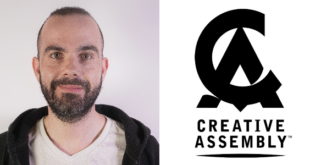What opportunities did the work on the new Deus Ex: Human Revolution afford Cubic Motion?
Gareth Edwards, company director: What we really demonstrated as a company working on Deus Ex was our ability to move very quickly, to take on a very large-scale production, and drop straight into a pipeline involving another studio (the excellent Goldtooth Creative) without adding any complexity to the overall process of building a great game. With enough effort it’s possible for plenty of studios to produce top-flight facial animation, but that also has to be matched by speed, reliability, consistency and value for money.
How does Cubic Motion approach facial mocap with a game like Deus Ex?
We don’t see ourselves as a technology vendor, rather an animation studio with a very niche specialisation – faces. Facial animation is so radically different from all other types of animation that we believe in collecting together a bunch of specialists who will spend all of their time focused on that alone.
We have no single fixed approach, and instead try to take an overall view of the right pipeline for each job. There are various capture methodologies we recommend – for example, we think video data can be more powerful than marker-based mocap in a lot of circumstances – but we’ll take any type of data from a client, including mocap, video or audio, and turn it into great animation.
So what distinguishes Cubic Motion from others offering facial mocap services and technology?
Most of the companies we’d regard as competitors tend to advocate a particular technology approach as the best. We would argue that any approach can ultimately produce good animation. After all, you can hand-key the stuff in the extreme case. The difference with Cubic is that you won’t find us selling a fixed method, rather presenting you with a range of choices.
The end result depends on a lot more than the technology – for example, we need to make sure that directors and actors are absolutely happy with the process. Given that budgets are finite, developers need the ability to step back and focus their resources appropriately. A great director and some extra days with the actors might give you more benefit than – for example – some extra mocap cameras. I think that our pricing is very competitive indeed and hopefully leaves room in developer’s budgets for all of the other elements which go towards making great game animation.
What trends are defining the future of facial mocap, and how is Cubic Motion preparing for the future in that regard?
Greater integration is really a common goal, since most developers these days like to minimise the number of steps within the production process. For example, we’re now starting to see some isolated cases of audio and motion capture both being captured on the same stage, although as of right now, very few motion capture stages are also audio stages.
To be able to capture the face at the same time as the body, there are a growing number of head-mounted cameras available. I think that a particular trend over the next two years will be live or near-live driving of facial animation, at least for pre-visualisation, which will then allow directors to sign-off performance on the day rather than wait for results after the actors have all packed up and gone home. Cubic Motion is currently developing a real-time system, partly supported by a research grant from the NWDA. We intend to launch the first beta of this in April and are excited to see how it ends up working for our clients.
What challenges remain in the facial motion capture discipline? How can they be overcome?
I think that we need to have a far wider understanding of the issues that really matter in animation. As an example, in traditional model-based animation – as opposed to vertex driving – you need to be using excellent rigs. You can have the most sophisticated motion capture stage in the whole world, but if the rig that you’re using is flaky, the results will always be poor.
We’re working on new tools and technology to speed up the process of creating great rigs for game developers, and this will remain a very active field of research elsewhere. As mentioned earlier, we need better systems for capturing data simultaneously, but in the mean time, if you have to choose, then one thing I’m very keen to get across is that capturing the face at the same time as audio is more important than capturing face and body together. Face and voice are far more sensitive to the tiny sync errors than face and body are.

 MCV/DEVELOP News, events, research and jobs from the games industry
MCV/DEVELOP News, events, research and jobs from the games industry



